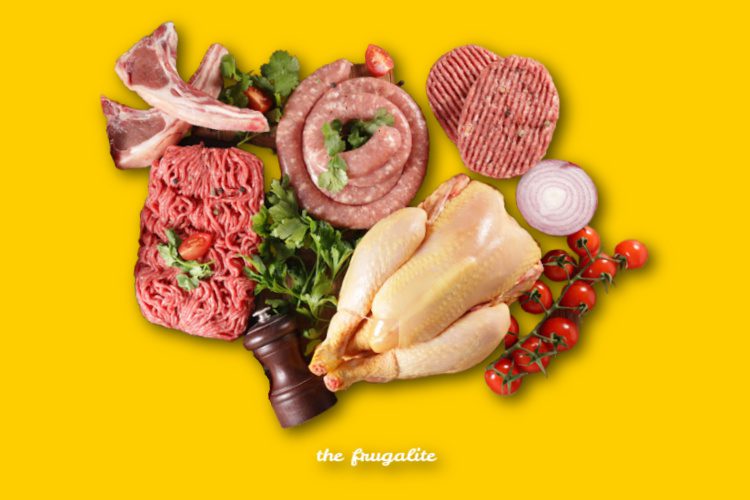(Psst: The FTC wants me to remind you that this website contains affiliate links. That means if you make a purchase from a link you click on, I might receive a small commission. This does not increase the price you’ll pay for that item nor does it decrease the awesomeness of the item. ~ Daisy)
The headline on Drudge Report several years back caught my attention. In large font, it screamed “Prices for Meat, Poultry, Fish and Eggs are at an All-Time High.” Now, meat prices are even worse. Between current supply chain issues, difficulties finding workers, the never-ending war on food, and ever-increasing taxes and regulations, you may be wondering if it’s even possible to buy meat on a budget.
So, what’s the concerned American to do?
Does this mean that you have to become a vegetarian? Does it mean that you have to eschew healthy hormone-free meats and go with the toxic grocery store offerings?
Not at all.
My last trip to the grocery store here in California was absolutely appalling. I vowed to use a combination of strategies to help our meat purchases go further.
Buy in bulk locally
The absolute best way to buy meat when you’re on a budget is to purchase in bulk and to do so locally. We purchase direct from a local farmer who field-raises his animals and doesn’t use hormones and antibiotics. You can buy a quarter or a half of a pig or cow, and you’ll pay on average a much lower price than you would if you bought the meat packaged separately over the course of the season.
As well, you are locking in your meat price by purchasing it all at once. This way, you won’t be strongly affected by the meat inflation until next season.
Here are a few tips for bulk purchases of meat on a budget:
- Check out the farm from which the meat originates. You want animals that were not raised in cramped factory farmed conditions, not fed GMO feed, and not injected with growth hormones and antibiotics. If you are making a purchase like this go for the best quality you can find.
- If that is more meat than your family can use, or more money than you can spend right now, consider going in with another family and splitting the purchase.
- You need a deep freezer in order to make the most of such a large purchase.
- I also like to can meat so that I am not as dependent on the electrical grid. Look into canning entire roasts, meatballs, or chili. (You can also check out my canning cookbook for more whole-food canning recipes.)
- Have the poorer cuts turned into stew meat or ground meat.
- Slow cooking a lower quality cut can turn something tough into something that melts in your mouth.
- Learn more about buying meat free of hormones and antibiotics HERE.
Eat leftovers
Often when you purchase meat in bulk, you end up cooking large portions. You probably won’t open a Styrofoam tray of chicken breasts, but instead you’ll purchase a whole chicken. You will be more likely to cook a stew or a roast. Have a plan for what you can do with those leftovers to extend them through another meal. Here are a few quick ideas:
- Make gravy – if you have a serving a meat too small to go around for all of your family members, consider making a gravy and serving it over mashed potatoes. Add some onion and mushrooms to the gravy to extend it even further.
- Make a soup or stew – this is another way to extend a serving that isn’t quite big enough to go around
- Mix it with beans and add Mexican seasoning to make burritos or to serve over rice.
- When you make a large roast, thinly slice the meat for sandwiches and salads throughout the work and school week.
- Cover leftover stew with pie crust or biscuit dough for a delicious potpie
- Look for recipes specifically written to use up leftovers. (This cookbook has some fantastic ideas.)
- If you have more leftovers than you can use before they spoil, sometimes they can be canned.
Don’t waste anything
Use up the things that most people throw away. When preparing the meat, if you are cutting away some fat or bone, place it in a bowl and put it in the freezer. When you have enough like scraps of meat, it’s time to make broth from it. You can make hearty broth from ham, turkey, chicken, beef, or pork – virtually any kind of meat. Use the inedible parts and cook it down for hours to get a rich and delicious broth. You can then use this broth as a base for soup or to cook your rice in to add a hit of nutrition.
Do you have such a tiny amount of leftovers that it won’t equal a full serving? Start a container in your freezer for those leftovers and create “leftover soup”. Sometimes it’s fantastic, sometimes it isn’t so great, but those odds and ends can combine to make meals that I consider to be basically “freebies.”
We always have a large Tupperware container in the freezer which contains little bits of vegetables or meat. Add a jar of homemade broth and a handful of rice, barley or pasta, and you’ve created “leftover soup.” It will be different every single time, based on your family’s leftovers.
Hunt and fish for meat on a budget
This answer isn’t for everyone. Some folks prefer to forget that the meat on the Styrofoam trays at the grocery store didn’t originate on those trays. Other’s have gotten locked in to a more narrow definition of “meat”, believing that the options are fish, pork, beef, and chicken. However, if you aren’t bothered by the concept of hunting, there is an abundance of meat walking, swimming, and flying around. Invest in a good game cookbook to best prepare meats that may not be familiar to you.
The only cost is the occasional lost lure, cartridge, or the initial setup for a set of traps as well!
You don’t have to actually do the hunting either. I’m fortunate to have some friends and neighbors who hunt. In exchange for some of the bounty, I’ve bartered my skills at canning things like venison chili or moose meatballs in spaghetti sauce.
If you fish, that can put an instant meal on the table. Learning to quickly and efficiently clean fish is a great skill and can gently prepare you for butchering other types of meat.
Perhaps with the sharp uptick in meat prices, it’s time to brush up on these skills and learn to harvest what is naturally abundant in your area.
Any suggestions?
How do you combat the outrageous meat prices? Share your ideas for how to buy meat on a budget in the comments section below.












8 thoughts on “How to Buy Meat on a Budget (Despite Skyrocketing Prices)”
Pay in cash it works almost every time
Crock pots (the real ones) work well for the “cheaper” cuts of meat. Been doing it for years.
We purchase ‘packages’ of meat from a local butcher shop. For a fixed amount (currently $80, up from $65 two years ago). You pick 4 ‘items’ ( ex. 8 lb pork sausage, 4 # chicken breasts, 5 # ground chuck, etc). It averages out to 3.99 to 4.29 a pound depending on the meat/cuts you choose. Much better than grocery store prices. More economical for just the 2 of us than splitting half a cow/pig since we don’t have anyone close to do that with.
Several years ago I bought half of a steer. My local butcher raises his own cows, the beef was wonderful. While I like to buy to buy organic sometimes my fixed budget will not stretch. Too ensure I have food for my brother and me, I shop the quick sales. I can still buy affordable meat that I put right into one of my two deep freezers. When I want ground meat I use the grinder attachment on my KitchenAide, no pink slime for us. I also buy produce that way. I freeze or dehydrate those. I have to work the quick sale items fast so they don’t go off. But the result is worth the effort.
If possible, you can also look for your local agricultural extension at the university. For example, in Tucson Arizona there is a student run meat store for the farming, food inspection and food processing classes. Might be a little difficult to find depending on what it’s called, but worth a look, and it is for a great cause. Also the meat is raised extremely well, and handled well too, because everyone is getting graded on it.
When you’re in the supermarket, check to see if there is a “manager’s special” or “clearance” refrigerated shelf in the meat section. You can find meat that is close to its “sell by” date in this section, marked down by up to 75%. Just be sure to take it right home and either use it or break it down to freeze it.
I do not recommend buying poultry in the clearance section (salmonella), but you can find good cuts of beef and pork there. They’re usually found at one end of the meat section. Also, if you’re lucky you can time when the butcher moves packages there. At my local Kroger it is between 9:00 and 9:30 during weekdays.
For those who decide to can at home the “Ball Blue Book” is a must have on the shelf.
https://www.amazon.com/Ball-Blue-Book-Guide-Preserving/dp/0972753745/ref=sr_1_1?hvadid=78271620523045&hvbmt=bb&hvdev=c&hvqmt=p&
keywords=ball+blue+book+of+canning&qid=1641754010&sr=8-1
Absolutely right, Marc. I’ve bought the updated versions over the years. My oldest one (I’ve kept it) is from the late 70s.